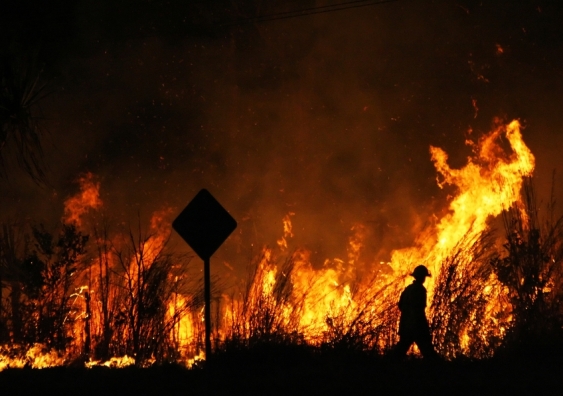Mastering Bushfire Readiness: The Duty of a BAL Assessment in Risk Mitigation
Wiki Article
Essential Tips for Bushfire Monitoring to Make Sure Fire Defense

Understanding Bushfire Risk Degrees
Recognizing the varying degrees of bushfire threat is vital for reliable planning and prep work in mitigating potential risks to lives and residential properties. Bushfire threat levels are normally classified based upon elements such as climate condition, gas schedule, topography, and historic fire behavior. By understanding these danger levels, areas and people can proactively execute methods to minimize susceptability and enhance durability in the face of potential bushfire events.The very first degree of bushfire risk is low threat, where the probability of a bushfire happening and triggering considerable harm is minimal. High-risk degrees represent a considerable risk, with problems helpful to rapid fire spread and severe fire behavior.
Recognizing these bushfire risk degrees makes it possible for stakeholders to tailor their readiness and feedback actions appropriately, making certain a efficient and positive strategy to bushfire management.
Establishing a Defensible Space
Efficient bushfire management starts with developing a defensible area around buildings to improve defense against possible fire hazards. A defensible space is a buffer zone that creates an obstacle between a structure and the bordering combustible plant life. This room functions as a critical line of defense, offering firemens a safe location to operate and assisting to minimize the threat of a fire spreading to the residential or commercial property.When developing a defensible area, it is important to take into consideration the format of the building and the bordering landscape. Clearing vegetation, particularly extremely flammable plants, within a certain radius of the home can assist prevent the quick spread of fires. Additionally, keeping a well-irrigated area around the residential property can additionally enhance its defensibility.
Routine maintenance of the defensible space is critical to ensure its performance. This consists of trimming overhanging branches, clearing dead plant life, and keeping the location without debris. By spending time and effort into developing and keeping a defensible room, homeowner can dramatically enhance their opportunities of protecting their homes and properties during a bushfire.
Carrying Out Fire-Resistant Landscaping
When making landscapes to reduce the danger of bushfires, integrating fireproof elements is vital for boosting home security and decreasing fire dangers. Carrying out fireproof landscape design includes calculated planning to develop a defensible area around frameworks. Start by choosing fire-resistant plant varieties that are much less most likely to fire up and generate reduced levels of combustible products. Select plants with high wetness content, low oil material, and very little dead vegetation to minimize the risk of fire spread. Additionally, keep appropriate spacing in between plants and maintain them effectively pruned to prevent fire from easily jumping between greenery.
Creating an Emergency Situation Emptying Plan
Creating an extensive emergency evacuation plan is vital for guaranteeing the safety and security and wellness of individuals during possible bushfire events (BAL Assessment). A reliable Discover More emptying plan ought to outline clear procedures to comply with in the occasion of a bushfire risk, including marked emptying courses, assembly factors, and interaction methodsTo begin developing an emergency situation evacuation plan, it is vital to analyze the details dangers and susceptabilities of your place. Recognize numerous discharge routes that cause safe areas far from the fire, taking into consideration factors such as surface, roadway access, and potential risks. Develop interaction channels to alert citizens of an upcoming evacuation, making use of methods such as alarms, message alerts, or door-to-door notifications.
Consistently evaluation and practice the discharge plan with all citizens or neighborhood participants to make sure everyone comprehends their responsibilities and functions. Conduct drills to examine the effectiveness of the strategy and make any kind of required changes. By having a well-prepared emptying plan in position, you can improve the chances of a safe and orderly discharge throughout a bushfire emergency situation.
Keeping Fire Safety Devices
After developing an extensive emergency situation evacuation plan for bushfire occurrences, it is necessary to prioritize the routine maintenance of fire safety equipment to make certain optimum performance and readiness. Routine maintenance of fire security tools such as fire extinguishers, smoke detectors, smoke alarm, and automatic sprinkler is essential in guarding lives and home throughout a bushfire. When required., performing regular evaluations, testing, and servicing of these tools by certified specialists is necessary to guarantee they are in functioning order.Fire extinguishers ought to be checked on a regular basis for pressure degrees, noticeable damages, and appropriate capability. By carefully maintaining fire security tools, people can improve their readiness and reaction abilities in the event of a bushfire.
Verdict
To conclude, reliable bushfire management includes comprehending danger levels, developing defensible rooms, executing fire-resistant landscape design, establishing evacuation learn this here now strategies, and maintaining fire safety tools. By adhering to these crucial pointers, people can ensure far better fire defense and safety for their residential properties and communities. It is essential to prioritize aggressive measures to alleviate the dangers connected with bushfires and to be planned click this link for emergencies.By comprehending the nuances of bushfire danger levels, establishing defensible areas, implementing fireproof landscape design, creating extensive evacuation plans, and making sure the upkeep of fire safety tools, areas and individuals can considerably bolster their resilience versus the ravages of wildfires - BMP. These suggestions are not just crucial for guarding against instant fire risks however likewise for cultivating lasting fire security methods that can make a substantial difference in the face of intensifying bushfire dangers
Risky levels indicate a considerable threat, with problems favorable to quick fire spread and extreme fire behavior. Regular maintenance of fire security devices such as fire extinguishers, smoke detectors, fire alarm systems, and sprinkler systems is crucial in guarding lives and property during a bushfire.In final thought, efficient bushfire monitoring entails comprehending threat degrees, creating defensible rooms, implementing fire-resistant landscape design, creating evacuation strategies, and maintaining fire security equipment.
Report this wiki page